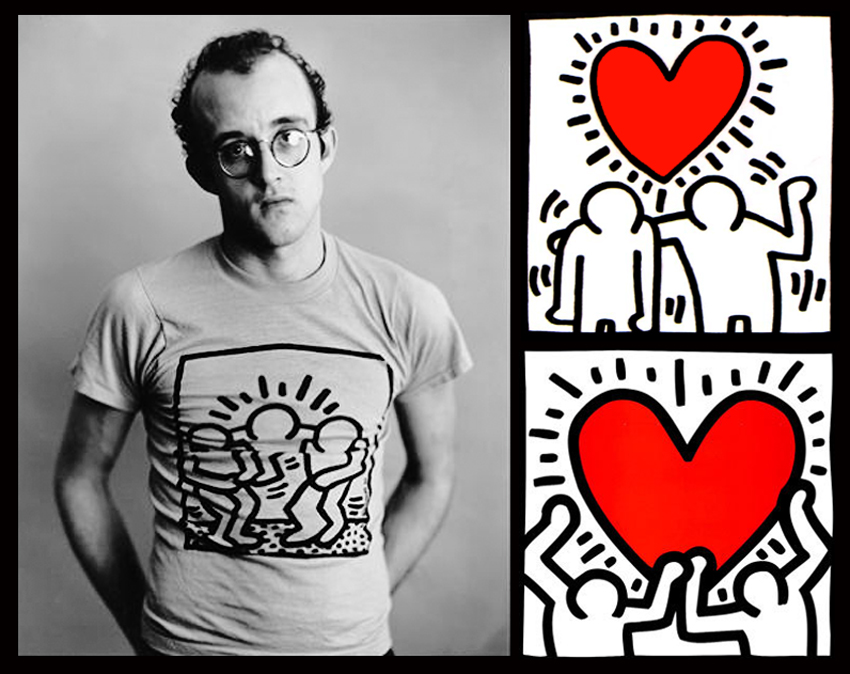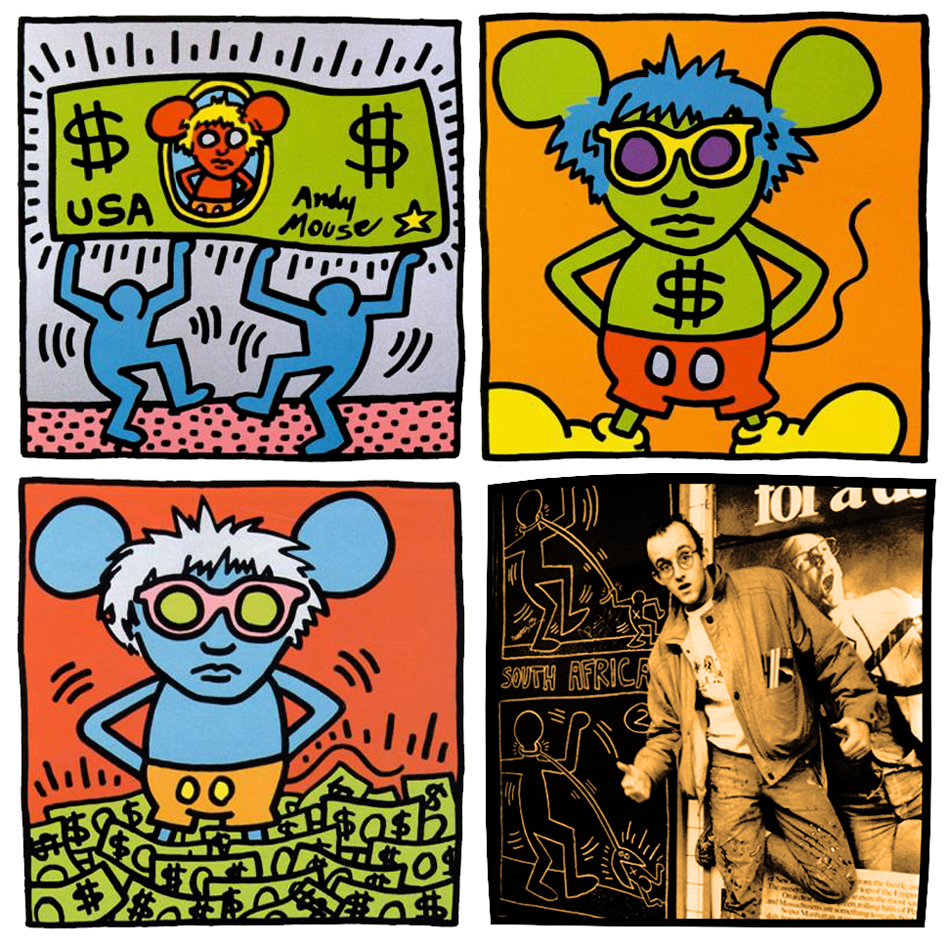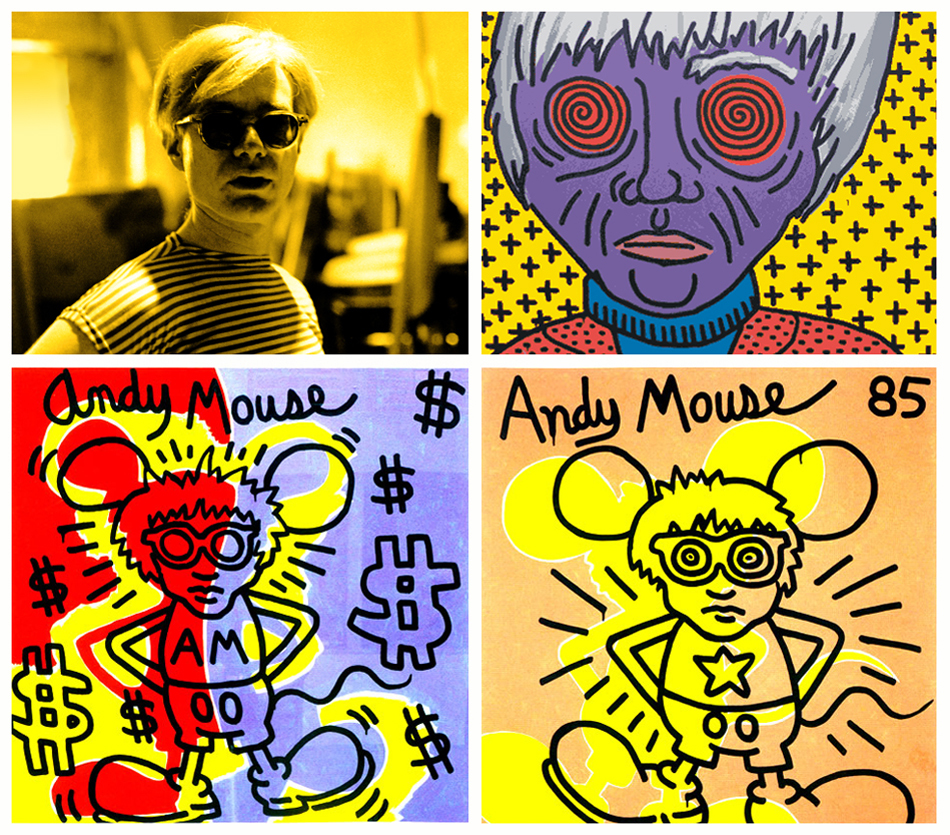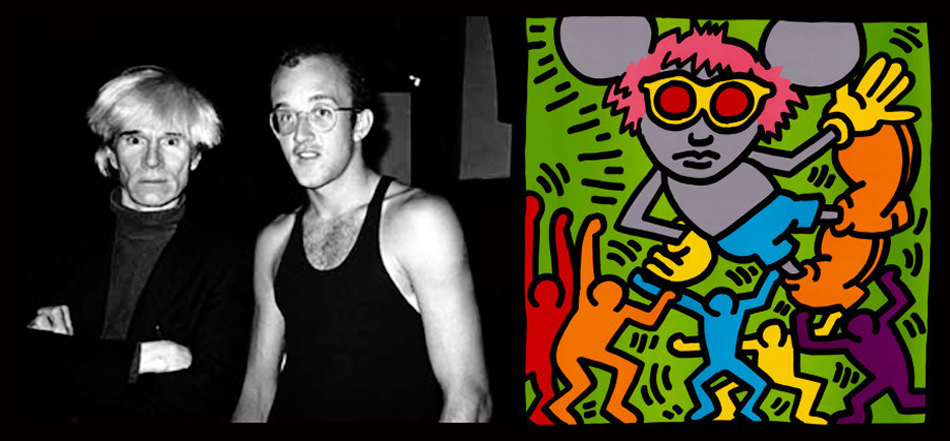“When I want to Keith Haring’s studio, I saw genius. I saw someone with a signature style – a style he seemed to be born with. Haring seemed to me to be like Andy Warhol, someone who knew that what he was doing was important, and he didn’t care if he worked fourteen or sixteen hours a day. His work was his entire world”.
(Henry Geldzahler about Keith Haring; “Keith Haring – The Authorized Biography” by John Gruen, A Fireside Book, 1991).
Pop artist and icon Keith Haring, much like his artistic idol Andy Warhol, used bright colors, bold lines and simple subject matters. He developed a unique visual lexicon. Essential concepts (birth, death, love, and war) were conveyed by the simplest of symbols: energy, waves, hearts, glowing babies (his most famous life giving symbol), barking dogs, and antic “everyman” figures.
Urban street culture became a defining influence on art, fashion, and music of the 1980′s, in particular in New York. Keith Haring was preeminent among the young artists, filmmakers, performers, and musicians whose work responded to these impulses and helped shape the culture of that decade.
Haring’s phenomenal rise from a talented graffiti artist, whose “radiant baby” became a worldwide symbol of 1980s pop culture, remains arguably as relevant today as when it was created despite being universally recognized as representative of that era. Painting with artistic and childlike exuberance, his talent was first recognized on subway platforms where he drew his trademark chalk figures and murals for all of New York to see. “When I did a drawing and went back a week later, the drawing was still there. It was neither smudged nor did anyone try to clean it off. I mean, it seemed to have this protective power that prevented people from destroying them. Another thing that I realized how many people were seeing these things. Within a week, when I’d be doing another drawing, people would come up to me and say, “So you’re the guy who did these drawings!” Because, see, there was never a signature. Nobody knew who was doing this stuff. And I started to realize the power and the potential of what I was doing.”
“It’s treating Warhol like he was part of American culture, like Mickey Mouse was.”
(Daniel Drenger, “Art and Life: An Interview with Keith Haring,” Columbia Art Review, Spring 1988).
Executed in 1985, and painted during an extremely fertile time for Keith Haring, Andy Mouse pays tribute to his close friend, hero and mentor, Andy Warhol, to whom Haring was introduced following his second exhibition in New York at the Tony Shafrazi Gallery in 1984. This historic encounter between Warhol and Haring brought together their mutual fascination with an “Art for Everybody,” and an admiration for Walt Disney, a man who inspired both artists. A friendship that developed almost immediately, Haring often visited Andy at the Factory and would trade works with him. Drawing on Warhol’s legacy, and similar to Disney, Haring created a world for both adults and children, in which art became a visual vocabulary and one that could be shared with everyone, as seen here on the animated canvas of Andy Mouse. Believing that cartoon figures could be an component of fine art, and regarding Andy Warhol and Walt Disney as heroes, Haring’s exuberant and enchanting Andy Mouse bonded together the work of these three significant artists.
Adaptating of one the most internationally recognized and celebrated cartoon characters, Haring presents the viewer with his hybrid Andy Mouse cartoon against the backdrop of a New Coke label; the product introduced the same year Andy Mouse was executed. This large-scale piece, evoking his wall drawings and subway posters, skillfully combines three different symbols of commerce: Coca-Cola, Mickey Mouse and Andy Warhol – with a deceptively simple palette of red, yellow, white and black, reintroducing the commercial colors of 1960s Pop Art.
Monumental in scale, Andy Mouse originated from a new body of work in which Haring focused on his passion for both drawing and mass production. Sharing with Warhol an understanding of the effect of mass media’s visual dynamics, Haring intuitively understood that good mass media imagery could be seen at any size and still make a strong visual impact. The use of scale that typifies mass media imagery is atypical of fine art, yet it runs through most of Haring’s art and appears as a common thread amongst his works.
Unlike the black line Haring frequently drew to define space in his work, the caricature of Andy Mouse is framed by the hard-edged white line of the New Coke label. By appropriating this brand logo and combining it with the repetitive use of the dollar sign, Haring brilliantly manipulates the concept of Pop into his own unique hand- drawn style.
Both Haring and Warhol liked Coca-Cola a lot. Warhol once described Coca-Cola, often served at Haring’s openings, as a highlight of democratic equality. Swept up into the Pop Art scene himself and endeavoring to present iconic images in a hand-crafted way, Haring blends this classic symbol of American mass culture into his own hand- painted canvas in a playful and energetic way.
Andy Mouse is a brilliant culmination of Haring’s entire oeuvre. Its bold graphic quality, complex composition and glorious color are high water marks for the artist. Andy Mouse’s large scale and brilliant postmodern referencing of Pop icons such as Coke and Mickey Mouse – by way of Andy Warhol – mark this as a seminal Haring work which remains relevant to contemporary art today.
By the time that Haring (1958-1990), a major supporter of good causes and Aids research and awareness, died at age 31, his work had moved from underground New York to the most prestigious galleries and museums around the world. Just like his hero Andy Warhol, Keith Haring has left a huge impact on the Pop Art culture world. Even though the master behind the creations has gone nearly two decades ago, Keith Haring’s art and messages are still alive.
Sources: Keith Haring, exhibition catalogue, Dexia Banque Int. à Luxembourg, 2007; Keith Haring, exhibition catalogue, Musée Art Contemporain Lyon, 2008; Christies auction catalogue, 2008; The Authorized Biography” by John Gruen, A Fireside Book, 1991.


























